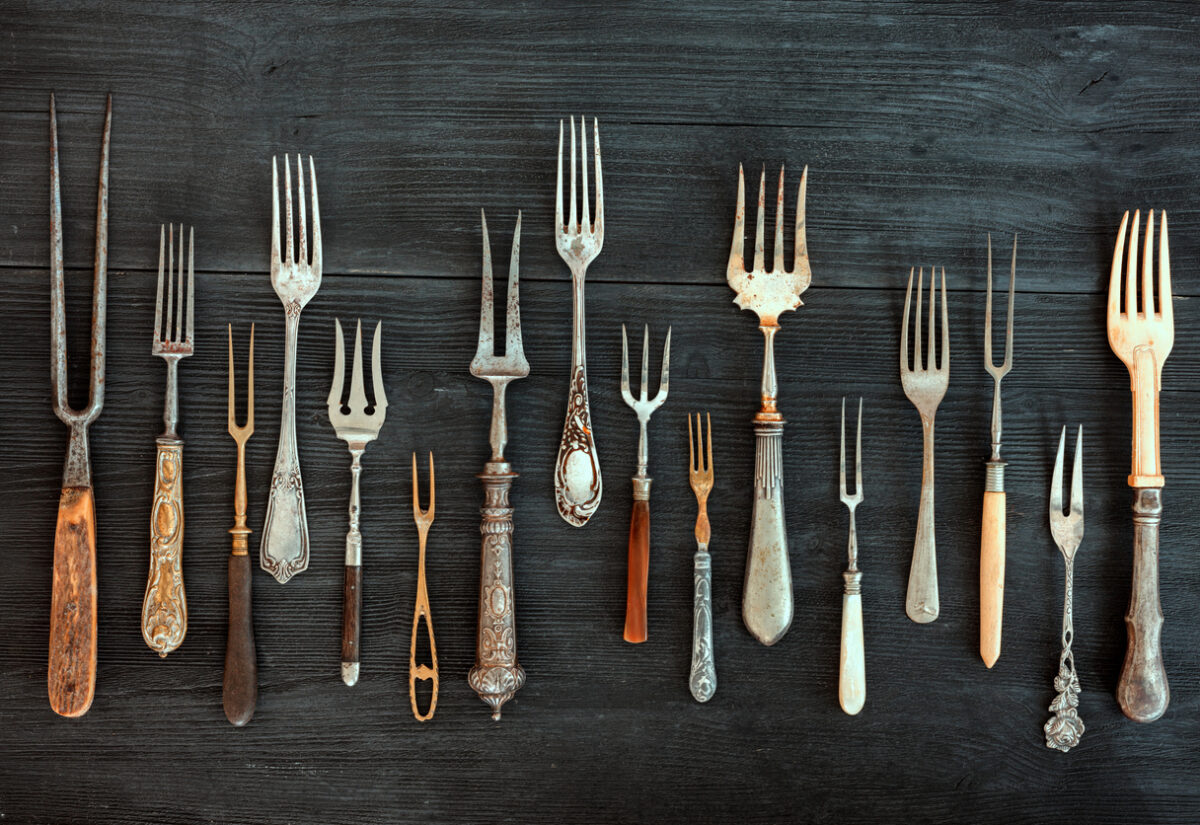Everyday Objects That Were Actually Luxury Items 500 Years Ago
- Gail Stewart
- May 11, 2025
 Getty Images/iStockphoto
Getty Images/iStockphotoToday, it’s easy to take things like cutlery, mirrors, or even sugar for granted. They’re everywhere—cheap, accessible, and part of daily life. But wind the clock back 500 years, and many of these seemingly mundane objects were considered precious luxuries. In Tudor and Renaissance Britain, status wasn’t just about land or titles—it extended into every corner of domestic life. The materials, the craftsmanship, the ability to afford certain household goods, and the way they were displayed all spoke volumes about your social standing. From tableware to toiletries, owning these items meant more than convenience. It meant class, wealth, and sometimes, access to a global trade network. Here are some everyday objects that were once considered markers of immense privilege.
Glass windows were a sign of real wealth.
In the 1500s, glass was both difficult and expensive to produce. The skill involved in blowing, flattening, and cutting glass made it inaccessible to the average home. Most people made do with wooden shutters, small slits in the wall, or thin sheets of translucent horn that allowed a little light through. Homes of the poor were often dark, smoky places, with minimal ventilation and little natural light.
Where glass windows were used, they were small, often divided into diamond-shaped panes held together with strips of lead. These were typically reserved for churches, monasteries, and the houses of the very rich. Some noble families had windows made in wooden frames so they could transport them from one estate to another, demonstrating just how valuable glass was. The ability to look out at your garden through clear glass rather than pushing open a shutter was, in itself, a statement of wealth.
Mirrors were rare and shockingly expensive.
In a world before factory production, every mirror was a bespoke object. High-quality glass was extremely hard to come by, and the process of coating the back of the glass with polished metal (typically a dangerous mix of tin and mercury) required expert craftsmanship.
The result? A small mirror could cost a fortune and was considered more of a decorative object than a functional one. Most people relied on polished brass or even water bowls to see a reflection. Owning a mirror wasn’t just about vanity—it meant you had access to luxury goods imported from European centres of craftsmanship, such as Venice or Nuremberg. Mirrors were often passed down through generations, protected with velvet or leather covers, and proudly displayed.
Sugar was a status symbol, not a pantry staple.
Today, sugar is in everything from cereal to ready meals, but in the 16th century, it was a precious import. Originating from plantations in the New World and the East Indies, sugar was expensive, difficult to transport, and controlled by global trade monopolies.
It wasn’t used casually. It was hoarded in locked boxes known as sugar chests, and its use was often reserved for guests or special occasions. Wealthy families would commission elaborate sugar sculptures known as subtleties—edible centrepieces shaped like castles, animals, or fruits. Some nobles even blackened their teeth on purpose to mimic the effects of sugar overconsumption, because rotten teeth became a twisted badge of wealth.
Forks were once a novelty.
Forks didn’t arrive in Britain in any meaningful way until the 1600s, and when they did, they caused controversy. They were seen as suspicious and unnecessary, even sacrilegious by some religious figures who believed eating with your fingers was a God-given right.
Early adopters of the fork were often mocked or treated with suspicion. But if you owned a fork, especially a silver or gold one, it marked you out as worldly, fashionable, and wealthy. They were often imported from Italy or France, and for many years, forks were used only at the most refined tables. Even then, guests often brought their own custom sets made from fine metal and carefully stored in ornate cases.
Books were a luxury for the literate elite.
Books before the printing press were hand-copied by scribes, sometimes taking years to complete, and bound in leather or wooden boards. After Gutenberg’s invention, books became somewhat more available, but the cost of paper, ink, and skilled labour still made them inaccessible to most.
Literacy itself was a sign of privilege. Those who could read and write—primarily the clergy, merchants, and nobility—might own a small collection of books, often religious or classical in theme. These volumes were treasured objects, kept in chests or displayed in private studies. A home with books, especially bound in leather with gilded lettering, wasn’t just literate—it was elite.
Soap was handmade and hard to come by.
Washing regularly wasn’t standard practice for most people in the 1500s, and for good reason: soap was expensive and unpleasant. It was typically made from animal fat and lye, producing a harsh, greasy product. For many, simply rinsing with water or rubbing down with herbs and cloth was the norm.
Perfumed soaps, imported from regions like Castile or the Ottoman Empire, were reserved for the wealthy. These soaps used olive oil and natural scents such as rose, lavender, or sandalwood. To use them wasn’t just about cleanliness. It was a public statement that you had access to foreign trade, good health, and refined living.
Clocks and watches were almost magical.
Mechanical timekeeping devices were rare and revered. Church bells and sundials were the main ways of tracking time for most people. Personal clocks and watches, however, were astonishingly expensive.
Clockmakers were specialists who created timepieces by hand, often embellishing them with precious metals or engravings. Early pocket watches, sometimes called “Nuremberg eggs” due to their shape, were prized items among the aristocracy. They weren’t very accurate, but their existence was more about showing off technological sophistication than punctuality.
Paper was precious.
We might waste paper without a second thought today, but in the 16th century, it was costly and sometimes handmade. Animal-based writing surfaces like parchment and vellum were still widely used for important documents, while paper was reserved for correspondences among the upper classes.
Ink and writing tools were similarly valuable. Quills needed constant maintenance, ink had to be mixed and stored carefully, and even wax for sealing letters was considered an added cost. Paper was rarely wasted—scraps were reused, margins filled with notes, and every inch carefully considered.
Buttons were a luxury detail.
Before the industrial age made them cheap and ubiquitous, buttons were made individually by hand. They were crafted from materials like ivory, bone, mother-of-pearl, or precious metals and often engraved or decorated.
Buttons weren’t purely functional. They were a sign of craftsmanship and wealth. Decorative buttons lined the garments of nobility and were often designed to be removable so they could be reused or inherited. Owning garments with detailed buttonwork meant you had money for custom tailoring and an eye for fashionable flair.
Cutlery was custom-made.
The idea of a drawer full of matching cutlery didn’t exist for most people. Knives were personal items, carried everywhere and used for everything. Spoons were often shared at table, and forks (if present at all) were reserved for the wealthy.
A matching set of cutlery, especially if made of silver or pewter, was a wedding gift or heirloom. These pieces were polished, stored carefully in lined boxes, and brought out for guests. Having an entire set meant you were not only wealthy but also had the space and lifestyle to host formal meals.
Table linens were reserved for the upper class.
The use of white tablecloths, napkins, and decorative runners was closely associated with wealth and refinement. Linen was expensive and time-consuming to clean and press. Owning multiple sets of table linen meant you had servants to launder them and enough crockery to warrant their use.
Lavish banquets were opportunities to display wealth through the use of multiple linens, colour-coordinated cloths, and elaborately folded napkins. Guests would judge your household not only on the food you served but on the fabric beneath it.



